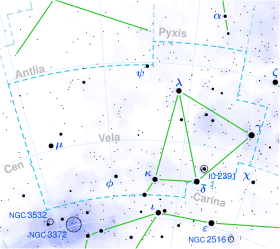Omicron Velorum
| Observation data Epoch J2000.0 Equinox J2000.0 | |
|---|---|
| Constellation | Vela |
| Right ascension | 08h 40m 17.58553s[1] |
| Declination | −52° 55′ 18.8002″[1] |
| Apparent magnitude (V) | +3.60[2] (3.57 – 3.63[3]) |
| Characteristics | |
| Spectral type | B3/5(V)[4] |
| U−B color index | −0.62[2] |
| B−V color index | −0.18[2] |
| Variable type | SPB[3] |
| Astrometry | |
| Radial velocity (Rv) | +16.1±0.7[5] km/s |
| Proper motion (μ) | RA: −24.42[1] mas/yr Dec.: +34.44[1] mas/yr |
| Parallax (π) | 6.61 ± 0.35 mas[1] |
| Distance | 490 ± 30 ly (151 ± 8 pc) |
| Absolute magnitude (MV) | −2.48[6] |
| Details | |
| Mass | 5.5±0.4[7] M☉ |
| Radius | 4.3±0.7[7] R☉ |
| Luminosity | 1,000[7] L☉ |
| Surface gravity (log g) | 3.91±0.20[7] cgs |
| Temperature | 16,200±700[7] K |
| Rotational velocity (v sin i) | 9±5[7] km/s |
| Age | 39.8[8] Myr |
| Other designations | |
| Database references | |
| SIMBAD | data |
Omicron Velorum (ο Vel, ο Velorum) is a star in the constellation Vela. It is the brightest member of the loose naked eye open cluster IC 2391, also known as the ο Velorum Cluster.

Omicron Velorum is a blue-white B-type star with a mean apparent magnitude of +3.60. It is probably a main sequence object,[4][10] but has also been classified as a subgiant or giant.[11] It is approximately 495 light years from Earth. A slowly pulsating B star, it ranges between magnitudes 3.57 and 3.63 over 2.8 days.[3]
The correct Bayer designation for ο Velorum has been debated. Lacaille assigned one Greek letter sequence for the bright stars of Argo Navis. These Lacaille designations are now shared across the three modern constellations of Carina, Puppis, and Vela so that (except for omicron) each Greek letter is found in only one of the three.[12][13] However, ο (omicron) is now commonly used for two stars, one each in Vela and Puppis. In the Coelum Australe Stelliferum itself, ο Velorum is labelled ο (omicron) Argus (du Navire in the French edition), while ο Puppis is labelled (Latin) o Argus in puppi (Pouppe du Navire in the French edition).[14][15][16] Some later authors state the reverse, that Lacaille actually assigned omicron to ο Puppis and Latin lower case 'o' to ο Velorum.[17]. Modern catalogs and atlases generally use omicron for both stars.
References
[edit]- ^ a b c d e van Leeuwen, F. (November 2007), "Validation of the new Hipparcos reduction", Astronomy and Astrophysics, 474 (2): 653–664, arXiv:0708.1752, Bibcode:2007A&A...474..653V, doi:10.1051/0004-6361:20078357, S2CID 18759600
- ^ a b c Johnson, H. L.; et al. (1966), "UBVRIJKL photometry of the bright stars", Communications of the Lunar and Planetary Laboratory, 4 (99): 99, Bibcode:1966CoLPL...4...99J
- ^ a b c Samus, N. N.; Durlevich, O. V.; et al. (2009). "VizieR Online Data Catalog: General Catalogue of Variable Stars (Samus+ 2007-2013)". VizieR On-line Data Catalog: B/GCVS. Originally Published in: 2009yCat....102025S. 1. Bibcode:2009yCat....102025S.
- ^ a b Houk, Nancy (1978). "Michigan catalogue of two-dimensional spectral types for the HD stars". Ann Arbor: Dept. Of Astronomy, University of Michigan. 2. Bibcode:1978MSS...C02....0H.
- ^ Gontcharov, G. A. (November 2006), "Pulkovo Compilation of Radial Velocities for 35495 Hipparcos stars in a common system", Astronomy Letters, 32 (11): 759–771, arXiv:1606.08053, Bibcode:2006AstL...32..759G, doi:10.1134/S1063773706110065, S2CID 119231169.
- ^ Anderson, E.; Francis, Ch. (2012), "XHIP: An extended hipparcos compilation", Astronomy Letters, 38 (5): 331, arXiv:1108.4971, Bibcode:2012AstL...38..331A, doi:10.1134/S1063773712050015, S2CID 119257644.
- ^ a b c d e f Hubrig, S.; et al. (January 2009), "New magnetic field measurements of beta Cephei stars and Slowly Pulsating B stars", Astronomische Nachrichten, 330 (4): 317, arXiv:0902.1314, Bibcode:2009AN....330..317H, doi:10.1002/asna.200811187, S2CID 17497112
- ^ Tetzlaff, N.; Neuhäuser, R.; Hohle, M. M. (1 January 2011). "A catalogue of young runaway Hipparcos stars within 3 kpc from the Sun: Catalogue of young runaway stars". Monthly Notices of the Royal Astronomical Society. 410 (1): 190–200. arXiv:1007.4883. Bibcode:2011MNRAS.410..190T. doi:10.1111/j.1365-2966.2010.17434.x. ISSN 0035-8711.
- ^ "MAST: Barbara A. Mikulski Archive for Space Telescopes". Space Telescope Science Institute. Retrieved 24 September 2022.
- ^ Vallenari, A.; et al. (Gaia collaboration) (2023). "Gaia Data Release 3. Summary of the content and survey properties". Astronomy and Astrophysics. 674: A1. arXiv:2208.00211. Bibcode:2023A&A...674A...1G. doi:10.1051/0004-6361/202243940. S2CID 244398875. Gaia DR3 record for this source at VizieR.
- ^ Skiff, B. A. (2014). "VizieR Online Data Catalog: Catalogue of Stellar Spectral Classifications (Skiff, 2009- )". VizieR On-line Data Catalog. Bibcode:2014yCat....1.2023S.
- ^ Coelum australe stelliferum ... H L Guerin & L F Delatour. 1763. pp. 7–.
- ^ Kostjuk, N. D. (2004). "VizieR Online Data Catalog: HD-DM-GC-HR-HIP-Bayer-Flamsteed Cross Index (Kostjuk, 2002)". VizieR On-line Data Catalog: IV/27A. Originally Published in: Institute of Astronomy of Russian Academy of Sciences (2002). 4027. Bibcode:2004yCat.4027....0K.
- ^ La Caille, Nicolas Louis de. "Coelum Australe Stelliferum". Retrieved 2017-07-21.
- ^ La Caille, Nicolas Louis de. "Coelum Australe Stelliferum". Retrieved 2017-07-21.
- ^ Wagman, Morton (2003). Lost Stars. McDonald and Woodward. p. 259. ISBN 0-939923-78-5.
- ^ Hoffleit, D.; Jaschek, C. (1982). "The Bright Star Catalogue". The Bright Star Catalogue. Bibcode:1982bsc..book.....H.

